Influencing Stakeholders: Analysis of Relationship Management Issues
VerifiedAdded on 2023/01/11
|7
|1602
|33
Report
AI Summary
This report analyzes a case study focused on relationship management within a pharmaceutical company. The report identifies challenges faced by a manager, including lack of coordination, team bonding, and knowledge gaps. It explores the importance of relationships, distinguishing between friendly and professional approaches. The analysis delves into the difficulties encountered and proposes alternative actions. Furthermore, it applies Tuckman's team development model to address the issues and suggests key elements for effective relationship management, such as good teams and fostering friendly and professional relations. The report concludes by emphasizing the importance of relationship management for business success and development, using the Tuckman model to reduce challenges.
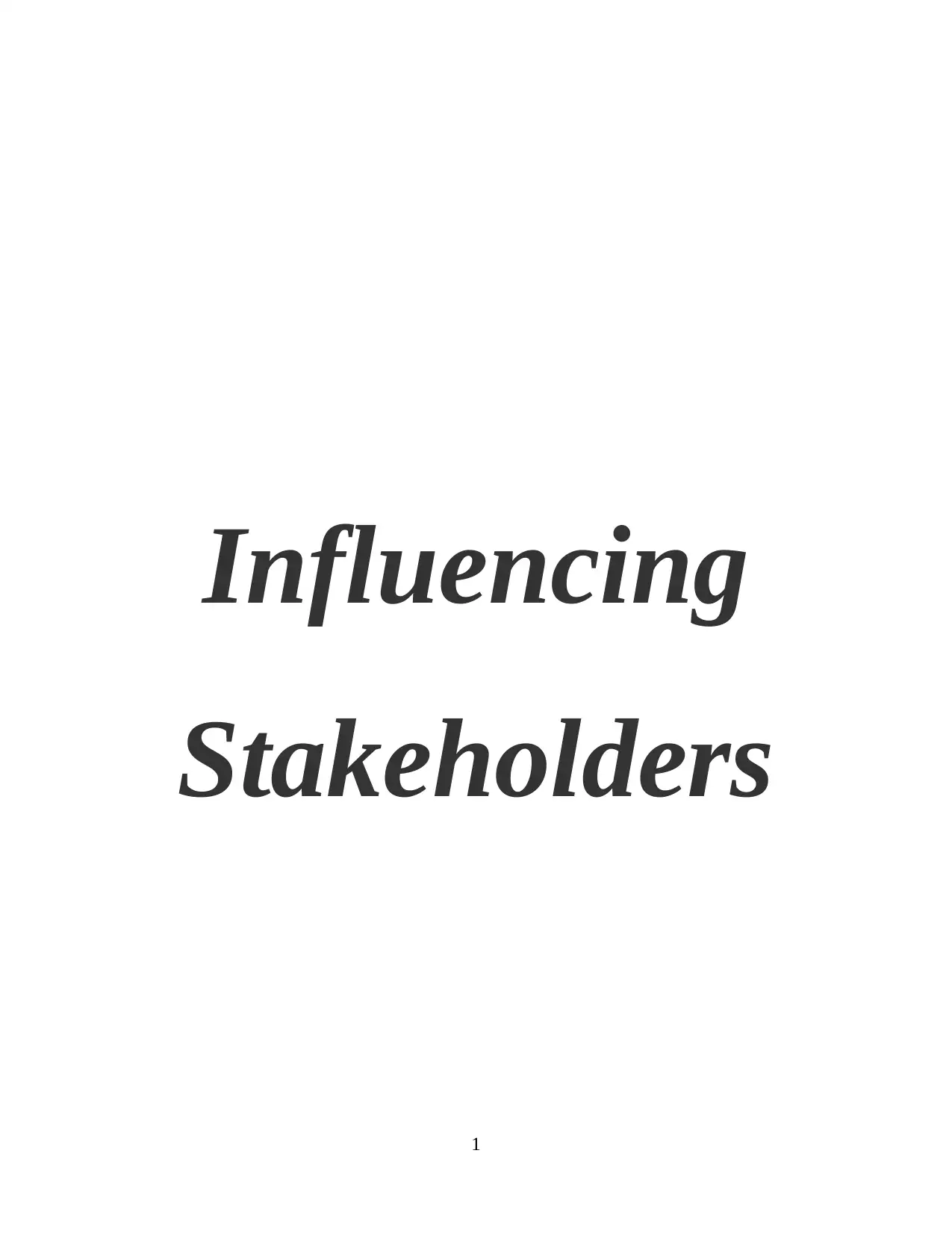
Influencing
Stakeholders
1
Stakeholders
1
Paraphrase This Document
Need a fresh take? Get an instant paraphrase of this document with our AI Paraphraser
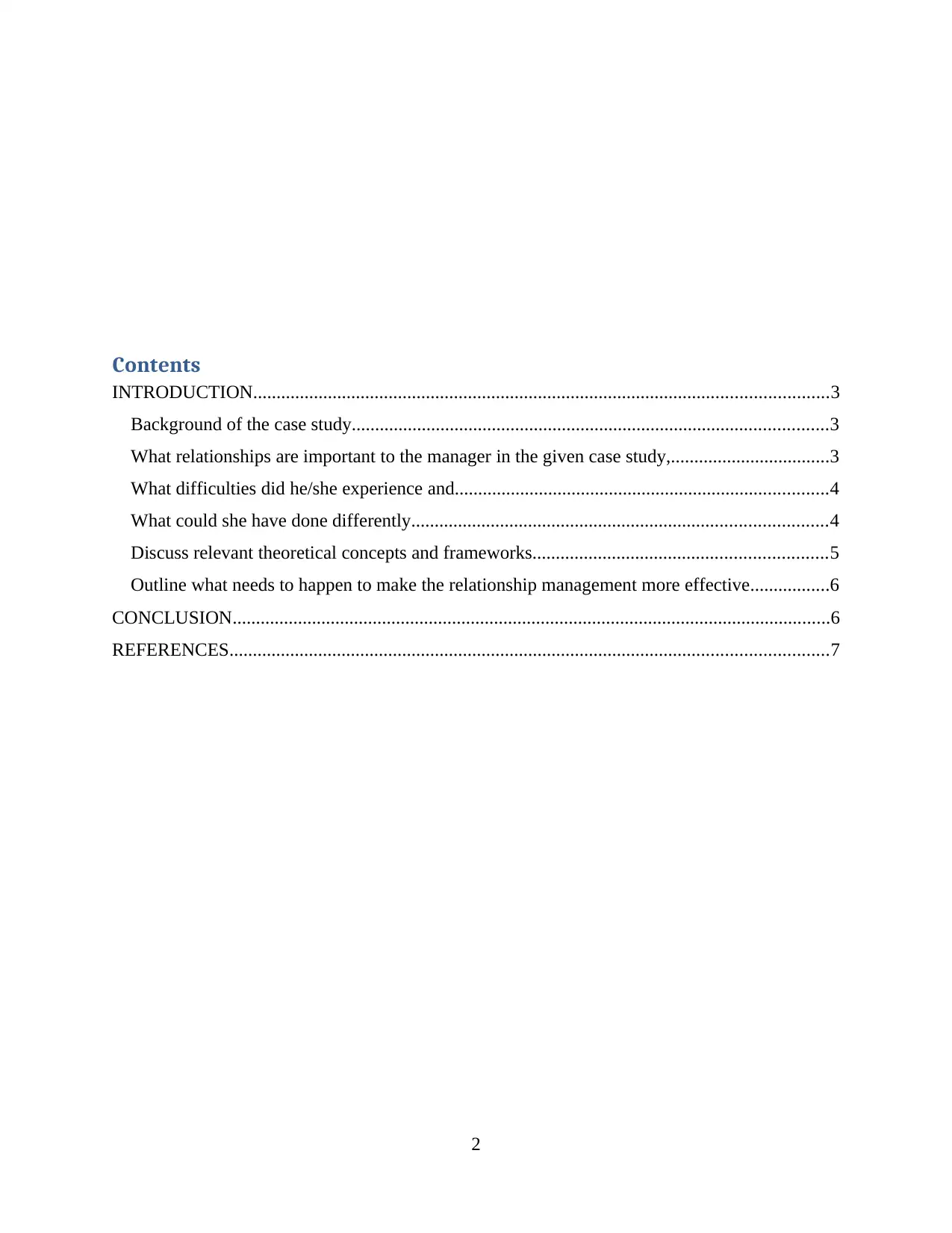
Contents
INTRODUCTION...........................................................................................................................3
Background of the case study......................................................................................................3
What relationships are important to the manager in the given case study,..................................3
What difficulties did he/she experience and................................................................................4
What could she have done differently.........................................................................................4
Discuss relevant theoretical concepts and frameworks...............................................................5
Outline what needs to happen to make the relationship management more effective.................6
CONCLUSION................................................................................................................................6
REFERENCES................................................................................................................................7
2
INTRODUCTION...........................................................................................................................3
Background of the case study......................................................................................................3
What relationships are important to the manager in the given case study,..................................3
What difficulties did he/she experience and................................................................................4
What could she have done differently.........................................................................................4
Discuss relevant theoretical concepts and frameworks...............................................................5
Outline what needs to happen to make the relationship management more effective.................6
CONCLUSION................................................................................................................................6
REFERENCES................................................................................................................................7
2
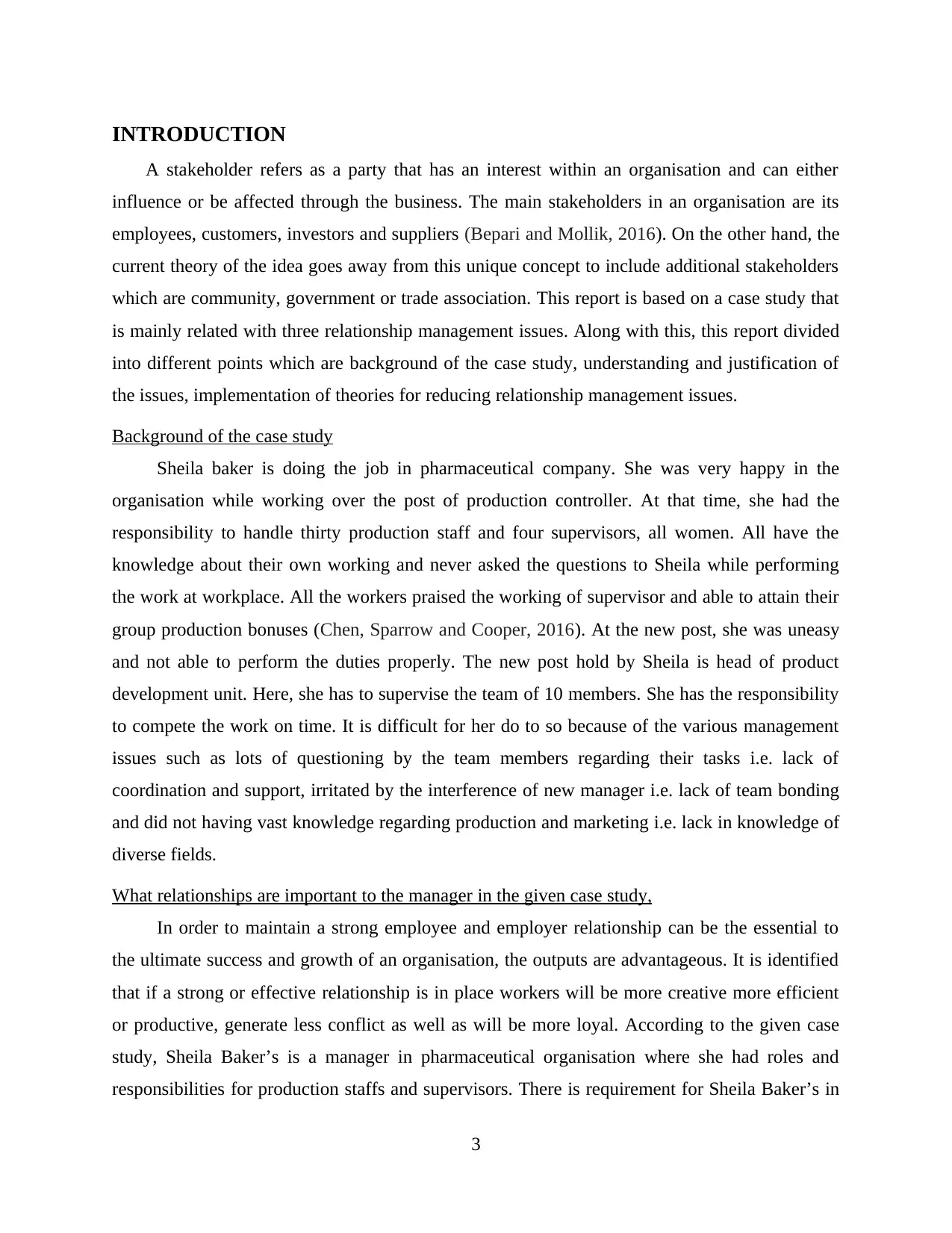
INTRODUCTION
A stakeholder refers as a party that has an interest within an organisation and can either
influence or be affected through the business. The main stakeholders in an organisation are its
employees, customers, investors and suppliers (Bepari and Mollik, 2016). On the other hand, the
current theory of the idea goes away from this unique concept to include additional stakeholders
which are community, government or trade association. This report is based on a case study that
is mainly related with three relationship management issues. Along with this, this report divided
into different points which are background of the case study, understanding and justification of
the issues, implementation of theories for reducing relationship management issues.
Background of the case study
Sheila baker is doing the job in pharmaceutical company. She was very happy in the
organisation while working over the post of production controller. At that time, she had the
responsibility to handle thirty production staff and four supervisors, all women. All have the
knowledge about their own working and never asked the questions to Sheila while performing
the work at workplace. All the workers praised the working of supervisor and able to attain their
group production bonuses (Chen, Sparrow and Cooper, 2016). At the new post, she was uneasy
and not able to perform the duties properly. The new post hold by Sheila is head of product
development unit. Here, she has to supervise the team of 10 members. She has the responsibility
to compete the work on time. It is difficult for her do to so because of the various management
issues such as lots of questioning by the team members regarding their tasks i.e. lack of
coordination and support, irritated by the interference of new manager i.e. lack of team bonding
and did not having vast knowledge regarding production and marketing i.e. lack in knowledge of
diverse fields.
What relationships are important to the manager in the given case study,
In order to maintain a strong employee and employer relationship can be the essential to
the ultimate success and growth of an organisation, the outputs are advantageous. It is identified
that if a strong or effective relationship is in place workers will be more creative more efficient
or productive, generate less conflict as well as will be more loyal. According to the given case
study, Sheila Baker’s is a manager in pharmaceutical organisation where she had roles and
responsibilities for production staffs and supervisors. There is requirement for Sheila Baker’s in
3
A stakeholder refers as a party that has an interest within an organisation and can either
influence or be affected through the business. The main stakeholders in an organisation are its
employees, customers, investors and suppliers (Bepari and Mollik, 2016). On the other hand, the
current theory of the idea goes away from this unique concept to include additional stakeholders
which are community, government or trade association. This report is based on a case study that
is mainly related with three relationship management issues. Along with this, this report divided
into different points which are background of the case study, understanding and justification of
the issues, implementation of theories for reducing relationship management issues.
Background of the case study
Sheila baker is doing the job in pharmaceutical company. She was very happy in the
organisation while working over the post of production controller. At that time, she had the
responsibility to handle thirty production staff and four supervisors, all women. All have the
knowledge about their own working and never asked the questions to Sheila while performing
the work at workplace. All the workers praised the working of supervisor and able to attain their
group production bonuses (Chen, Sparrow and Cooper, 2016). At the new post, she was uneasy
and not able to perform the duties properly. The new post hold by Sheila is head of product
development unit. Here, she has to supervise the team of 10 members. She has the responsibility
to compete the work on time. It is difficult for her do to so because of the various management
issues such as lots of questioning by the team members regarding their tasks i.e. lack of
coordination and support, irritated by the interference of new manager i.e. lack of team bonding
and did not having vast knowledge regarding production and marketing i.e. lack in knowledge of
diverse fields.
What relationships are important to the manager in the given case study,
In order to maintain a strong employee and employer relationship can be the essential to
the ultimate success and growth of an organisation, the outputs are advantageous. It is identified
that if a strong or effective relationship is in place workers will be more creative more efficient
or productive, generate less conflict as well as will be more loyal. According to the given case
study, Sheila Baker’s is a manager in pharmaceutical organisation where she had roles and
responsibilities for production staffs and supervisors. There is requirement for Sheila Baker’s in
3
⊘ This is a preview!⊘
Do you want full access?
Subscribe today to unlock all pages.

Trusted by 1+ million students worldwide
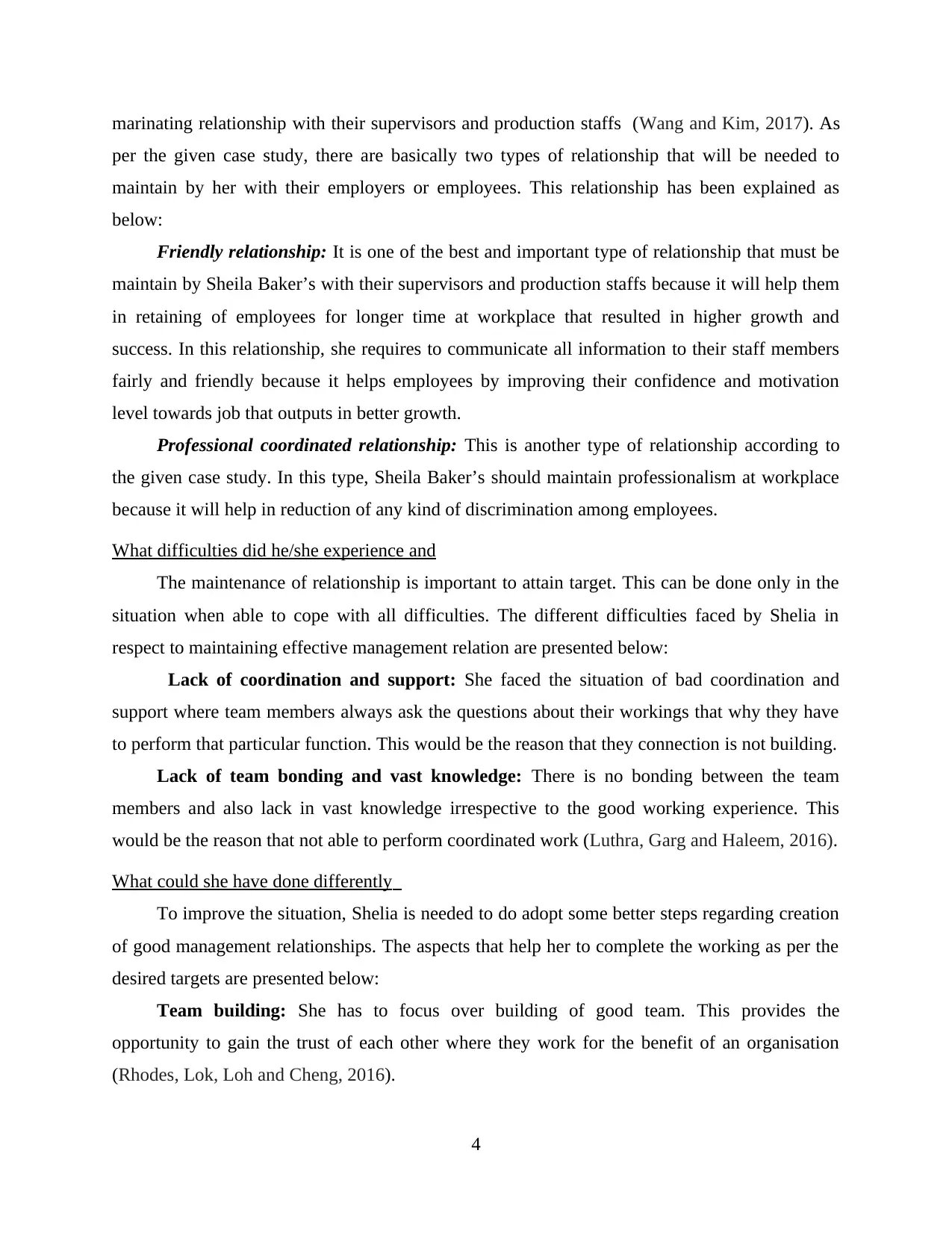
marinating relationship with their supervisors and production staffs (Wang and Kim, 2017). As
per the given case study, there are basically two types of relationship that will be needed to
maintain by her with their employers or employees. This relationship has been explained as
below:
Friendly relationship: It is one of the best and important type of relationship that must be
maintain by Sheila Baker’s with their supervisors and production staffs because it will help them
in retaining of employees for longer time at workplace that resulted in higher growth and
success. In this relationship, she requires to communicate all information to their staff members
fairly and friendly because it helps employees by improving their confidence and motivation
level towards job that outputs in better growth.
Professional coordinated relationship: This is another type of relationship according to
the given case study. In this type, Sheila Baker’s should maintain professionalism at workplace
because it will help in reduction of any kind of discrimination among employees.
What difficulties did he/she experience and
The maintenance of relationship is important to attain target. This can be done only in the
situation when able to cope with all difficulties. The different difficulties faced by Shelia in
respect to maintaining effective management relation are presented below:
Lack of coordination and support: She faced the situation of bad coordination and
support where team members always ask the questions about their workings that why they have
to perform that particular function. This would be the reason that they connection is not building.
Lack of team bonding and vast knowledge: There is no bonding between the team
members and also lack in vast knowledge irrespective to the good working experience. This
would be the reason that not able to perform coordinated work (Luthra, Garg and Haleem, 2016).
What could she have done differently
To improve the situation, Shelia is needed to do adopt some better steps regarding creation
of good management relationships. The aspects that help her to complete the working as per the
desired targets are presented below:
Team building: She has to focus over building of good team. This provides the
opportunity to gain the trust of each other where they work for the benefit of an organisation
(Rhodes, Lok, Loh and Cheng, 2016).
4
per the given case study, there are basically two types of relationship that will be needed to
maintain by her with their employers or employees. This relationship has been explained as
below:
Friendly relationship: It is one of the best and important type of relationship that must be
maintain by Sheila Baker’s with their supervisors and production staffs because it will help them
in retaining of employees for longer time at workplace that resulted in higher growth and
success. In this relationship, she requires to communicate all information to their staff members
fairly and friendly because it helps employees by improving their confidence and motivation
level towards job that outputs in better growth.
Professional coordinated relationship: This is another type of relationship according to
the given case study. In this type, Sheila Baker’s should maintain professionalism at workplace
because it will help in reduction of any kind of discrimination among employees.
What difficulties did he/she experience and
The maintenance of relationship is important to attain target. This can be done only in the
situation when able to cope with all difficulties. The different difficulties faced by Shelia in
respect to maintaining effective management relation are presented below:
Lack of coordination and support: She faced the situation of bad coordination and
support where team members always ask the questions about their workings that why they have
to perform that particular function. This would be the reason that they connection is not building.
Lack of team bonding and vast knowledge: There is no bonding between the team
members and also lack in vast knowledge irrespective to the good working experience. This
would be the reason that not able to perform coordinated work (Luthra, Garg and Haleem, 2016).
What could she have done differently
To improve the situation, Shelia is needed to do adopt some better steps regarding creation
of good management relationships. The aspects that help her to complete the working as per the
desired targets are presented below:
Team building: She has to focus over building of good team. This provides the
opportunity to gain the trust of each other where they work for the benefit of an organisation
(Rhodes, Lok, Loh and Cheng, 2016).
4
Paraphrase This Document
Need a fresh take? Get an instant paraphrase of this document with our AI Paraphraser
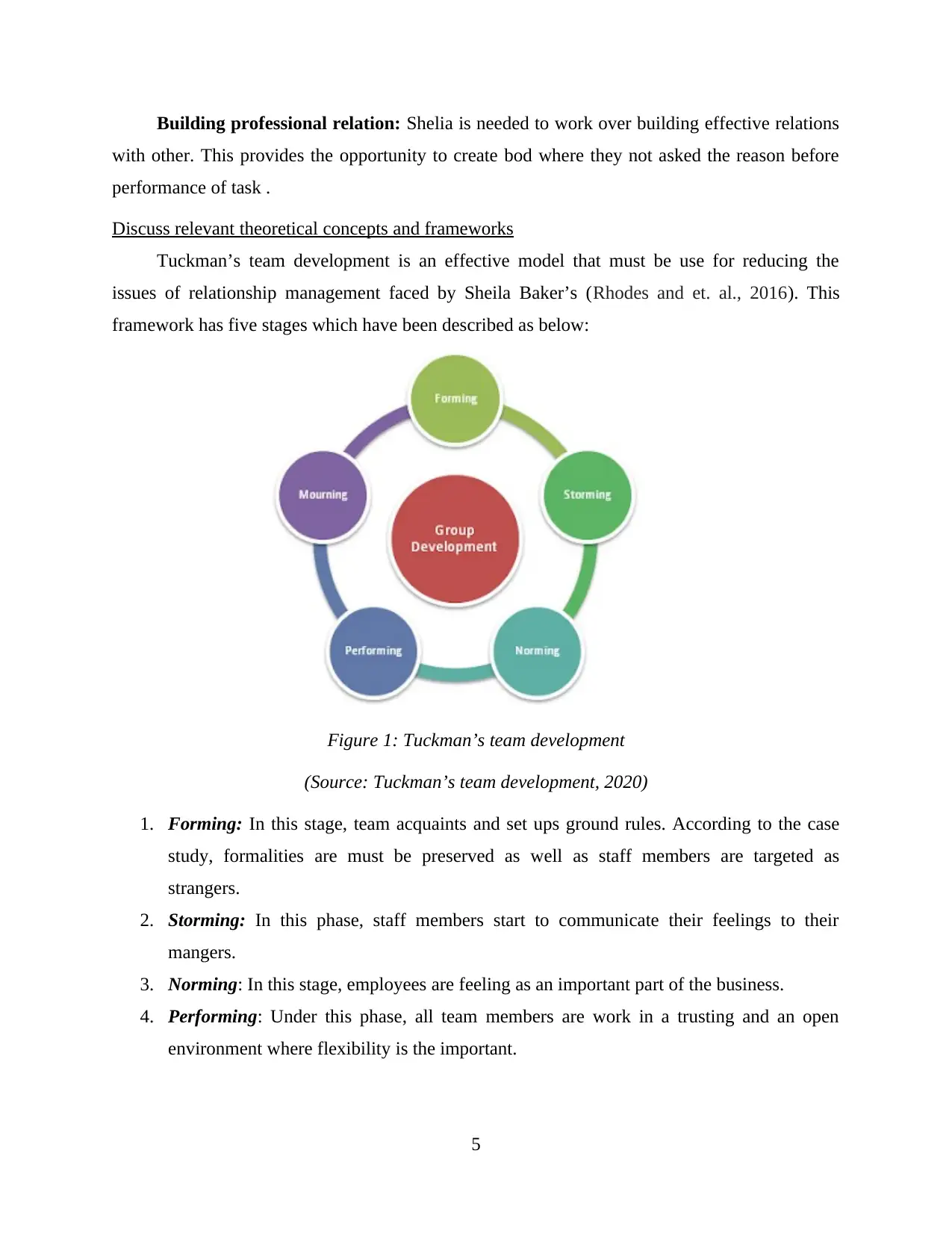
Building professional relation: Shelia is needed to work over building effective relations
with other. This provides the opportunity to create bod where they not asked the reason before
performance of task .
Discuss relevant theoretical concepts and frameworks
Tuckman’s team development is an effective model that must be use for reducing the
issues of relationship management faced by Sheila Baker’s (Rhodes and et. al., 2016). This
framework has five stages which have been described as below:
Figure 1: Tuckman’s team development
(Source: Tuckman’s team development, 2020)
1. Forming: In this stage, team acquaints and set ups ground rules. According to the case
study, formalities are must be preserved as well as staff members are targeted as
strangers.
2. Storming: In this phase, staff members start to communicate their feelings to their
mangers.
3. Norming: In this stage, employees are feeling as an important part of the business.
4. Performing: Under this phase, all team members are work in a trusting and an open
environment where flexibility is the important.
5
with other. This provides the opportunity to create bod where they not asked the reason before
performance of task .
Discuss relevant theoretical concepts and frameworks
Tuckman’s team development is an effective model that must be use for reducing the
issues of relationship management faced by Sheila Baker’s (Rhodes and et. al., 2016). This
framework has five stages which have been described as below:
Figure 1: Tuckman’s team development
(Source: Tuckman’s team development, 2020)
1. Forming: In this stage, team acquaints and set ups ground rules. According to the case
study, formalities are must be preserved as well as staff members are targeted as
strangers.
2. Storming: In this phase, staff members start to communicate their feelings to their
mangers.
3. Norming: In this stage, employees are feeling as an important part of the business.
4. Performing: Under this phase, all team members are work in a trusting and an open
environment where flexibility is the important.
5
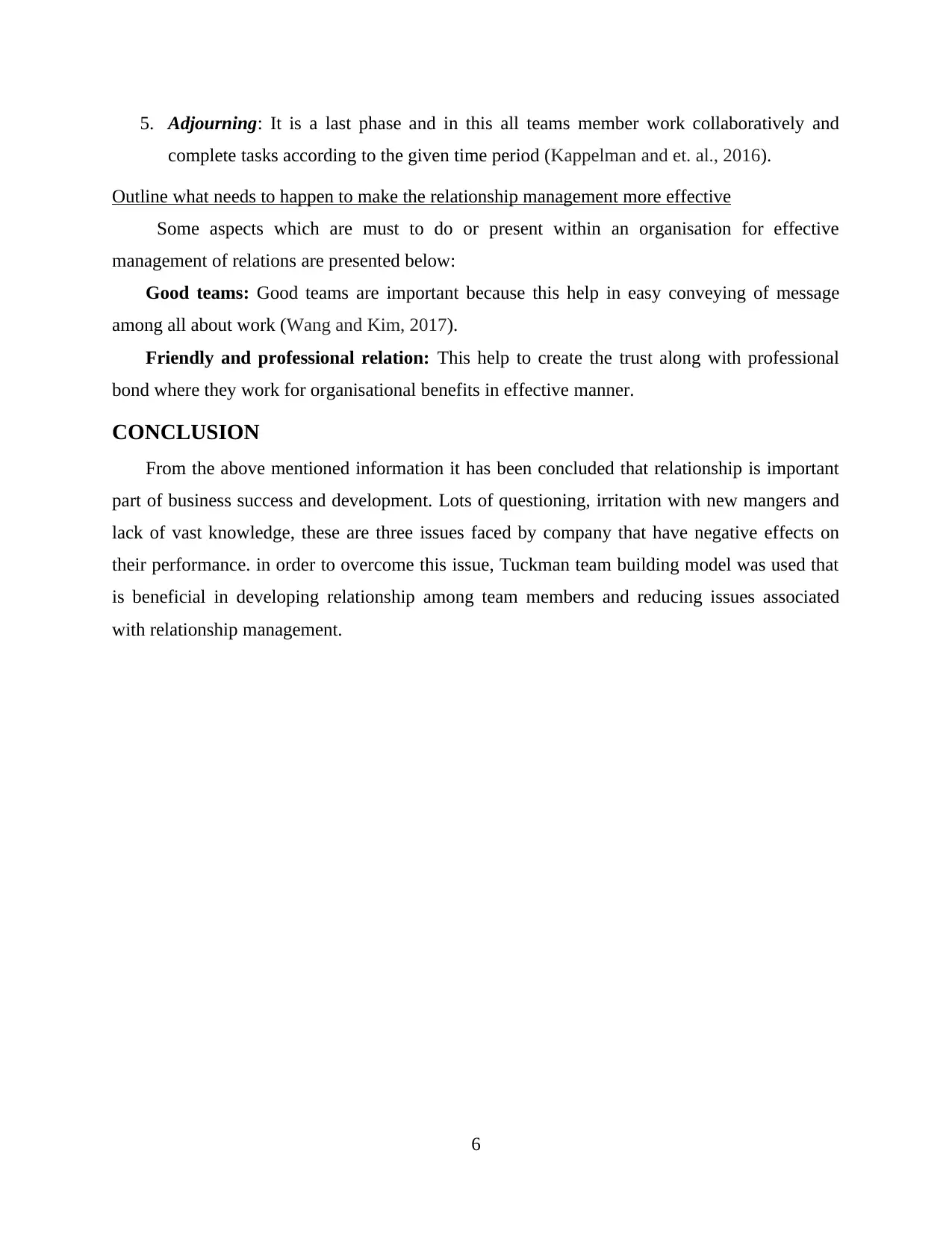
5. Adjourning: It is a last phase and in this all teams member work collaboratively and
complete tasks according to the given time period (Kappelman and et. al., 2016).
Outline what needs to happen to make the relationship management more effective
Some aspects which are must to do or present within an organisation for effective
management of relations are presented below:
Good teams: Good teams are important because this help in easy conveying of message
among all about work (Wang and Kim, 2017).
Friendly and professional relation: This help to create the trust along with professional
bond where they work for organisational benefits in effective manner.
CONCLUSION
From the above mentioned information it has been concluded that relationship is important
part of business success and development. Lots of questioning, irritation with new mangers and
lack of vast knowledge, these are three issues faced by company that have negative effects on
their performance. in order to overcome this issue, Tuckman team building model was used that
is beneficial in developing relationship among team members and reducing issues associated
with relationship management.
6
complete tasks according to the given time period (Kappelman and et. al., 2016).
Outline what needs to happen to make the relationship management more effective
Some aspects which are must to do or present within an organisation for effective
management of relations are presented below:
Good teams: Good teams are important because this help in easy conveying of message
among all about work (Wang and Kim, 2017).
Friendly and professional relation: This help to create the trust along with professional
bond where they work for organisational benefits in effective manner.
CONCLUSION
From the above mentioned information it has been concluded that relationship is important
part of business success and development. Lots of questioning, irritation with new mangers and
lack of vast knowledge, these are three issues faced by company that have negative effects on
their performance. in order to overcome this issue, Tuckman team building model was used that
is beneficial in developing relationship among team members and reducing issues associated
with relationship management.
6
⊘ This is a preview!⊘
Do you want full access?
Subscribe today to unlock all pages.

Trusted by 1+ million students worldwide
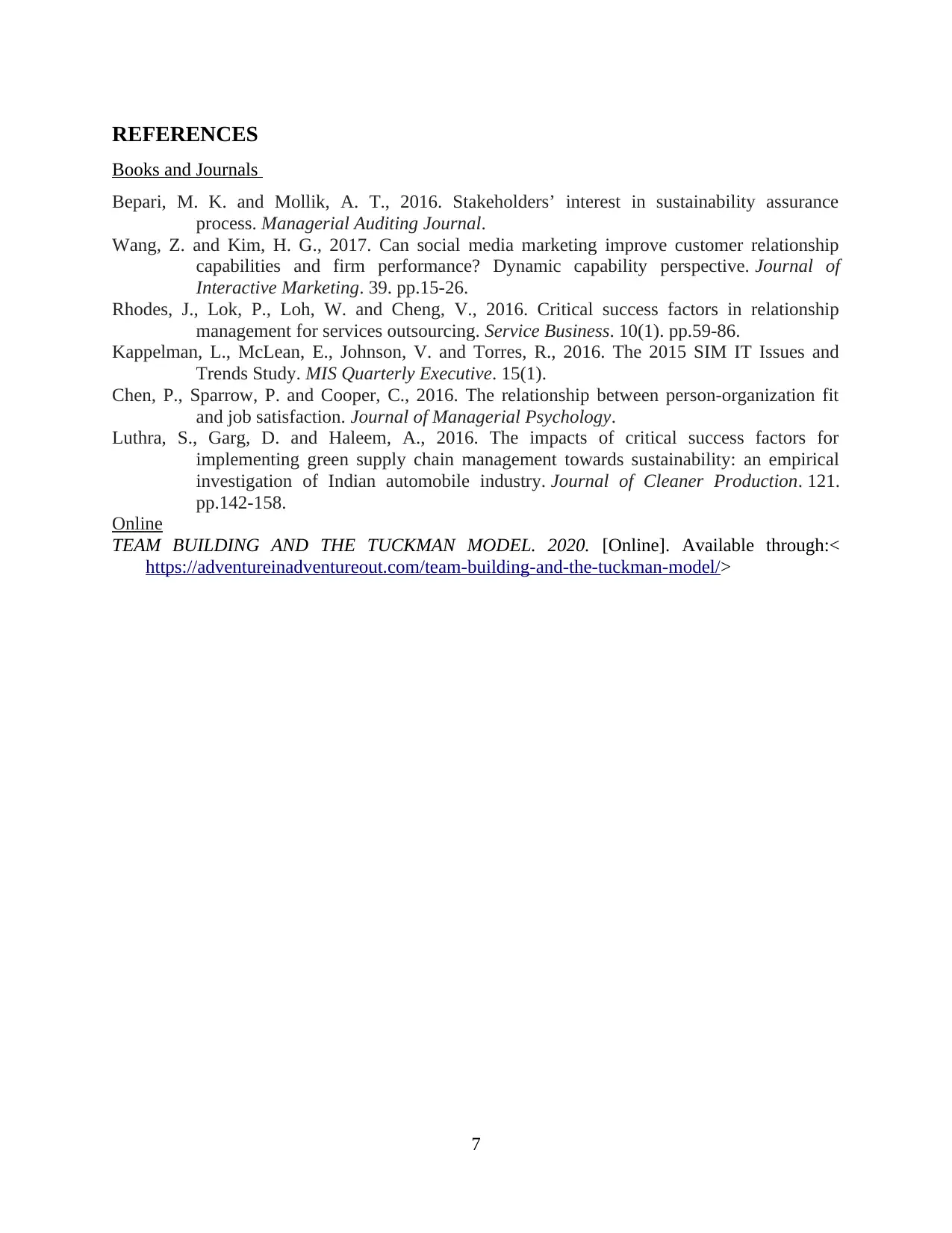
REFERENCES
Books and Journals
Bepari, M. K. and Mollik, A. T., 2016. Stakeholders’ interest in sustainability assurance
process. Managerial Auditing Journal.
Wang, Z. and Kim, H. G., 2017. Can social media marketing improve customer relationship
capabilities and firm performance? Dynamic capability perspective. Journal of
Interactive Marketing. 39. pp.15-26.
Rhodes, J., Lok, P., Loh, W. and Cheng, V., 2016. Critical success factors in relationship
management for services outsourcing. Service Business. 10(1). pp.59-86.
Kappelman, L., McLean, E., Johnson, V. and Torres, R., 2016. The 2015 SIM IT Issues and
Trends Study. MIS Quarterly Executive. 15(1).
Chen, P., Sparrow, P. and Cooper, C., 2016. The relationship between person-organization fit
and job satisfaction. Journal of Managerial Psychology.
Luthra, S., Garg, D. and Haleem, A., 2016. The impacts of critical success factors for
implementing green supply chain management towards sustainability: an empirical
investigation of Indian automobile industry. Journal of Cleaner Production. 121.
pp.142-158.
Online
TEAM BUILDING AND THE TUCKMAN MODEL. 2020. [Online]. Available through:<
https://adventureinadventureout.com/team-building-and-the-tuckman-model/>
7
Books and Journals
Bepari, M. K. and Mollik, A. T., 2016. Stakeholders’ interest in sustainability assurance
process. Managerial Auditing Journal.
Wang, Z. and Kim, H. G., 2017. Can social media marketing improve customer relationship
capabilities and firm performance? Dynamic capability perspective. Journal of
Interactive Marketing. 39. pp.15-26.
Rhodes, J., Lok, P., Loh, W. and Cheng, V., 2016. Critical success factors in relationship
management for services outsourcing. Service Business. 10(1). pp.59-86.
Kappelman, L., McLean, E., Johnson, V. and Torres, R., 2016. The 2015 SIM IT Issues and
Trends Study. MIS Quarterly Executive. 15(1).
Chen, P., Sparrow, P. and Cooper, C., 2016. The relationship between person-organization fit
and job satisfaction. Journal of Managerial Psychology.
Luthra, S., Garg, D. and Haleem, A., 2016. The impacts of critical success factors for
implementing green supply chain management towards sustainability: an empirical
investigation of Indian automobile industry. Journal of Cleaner Production. 121.
pp.142-158.
Online
TEAM BUILDING AND THE TUCKMAN MODEL. 2020. [Online]. Available through:<
https://adventureinadventureout.com/team-building-and-the-tuckman-model/>
7
1 out of 7
Related Documents
Your All-in-One AI-Powered Toolkit for Academic Success.
+13062052269
info@desklib.com
Available 24*7 on WhatsApp / Email
![[object Object]](/_next/static/media/star-bottom.7253800d.svg)
Unlock your academic potential
Copyright © 2020–2025 A2Z Services. All Rights Reserved. Developed and managed by ZUCOL.



